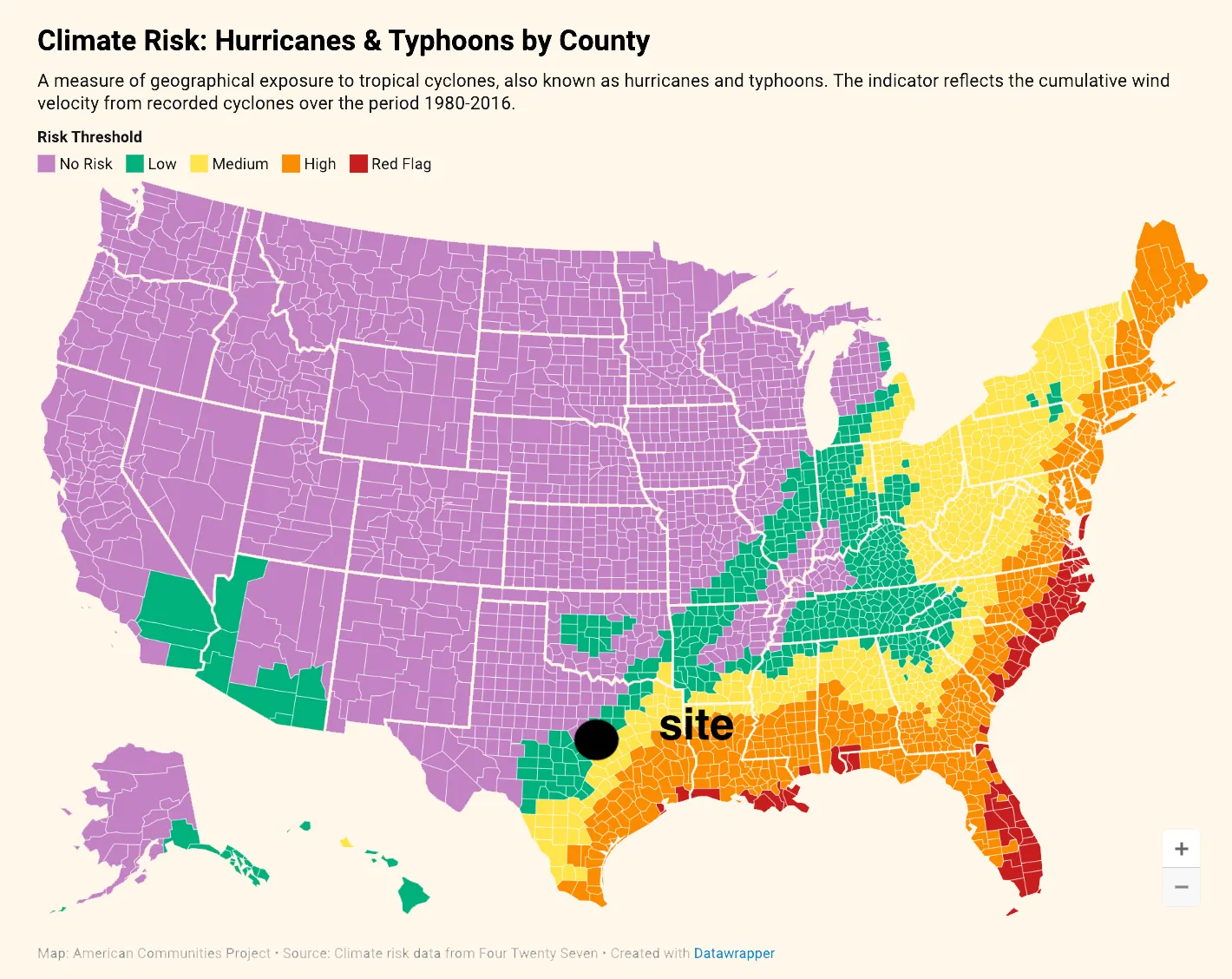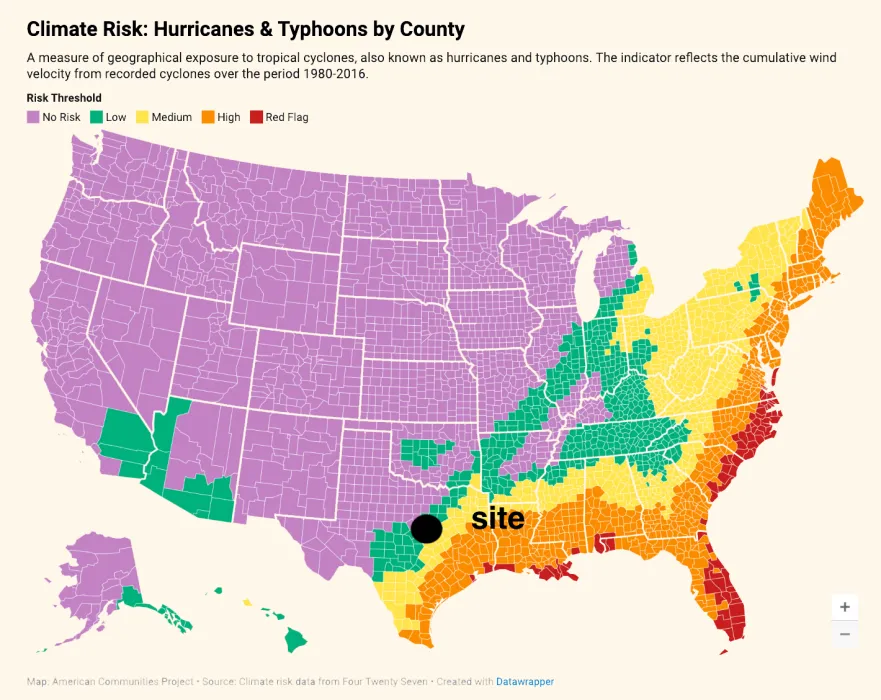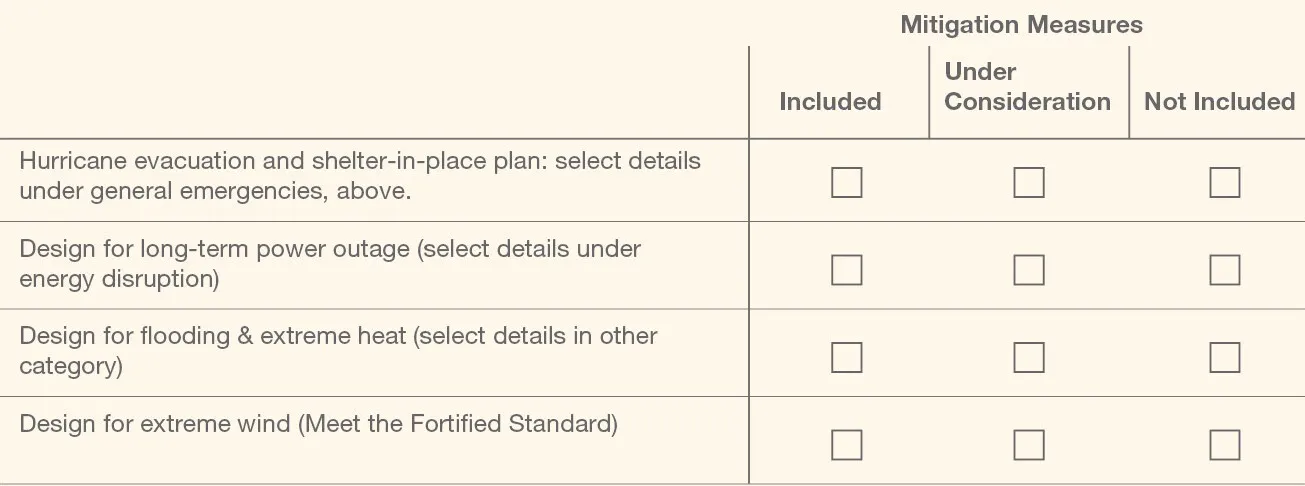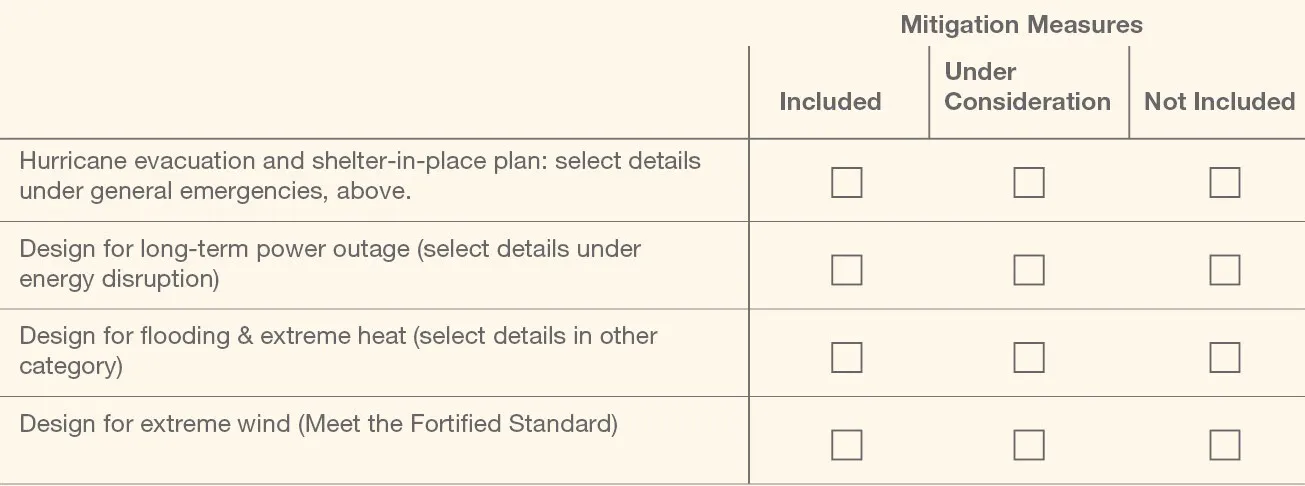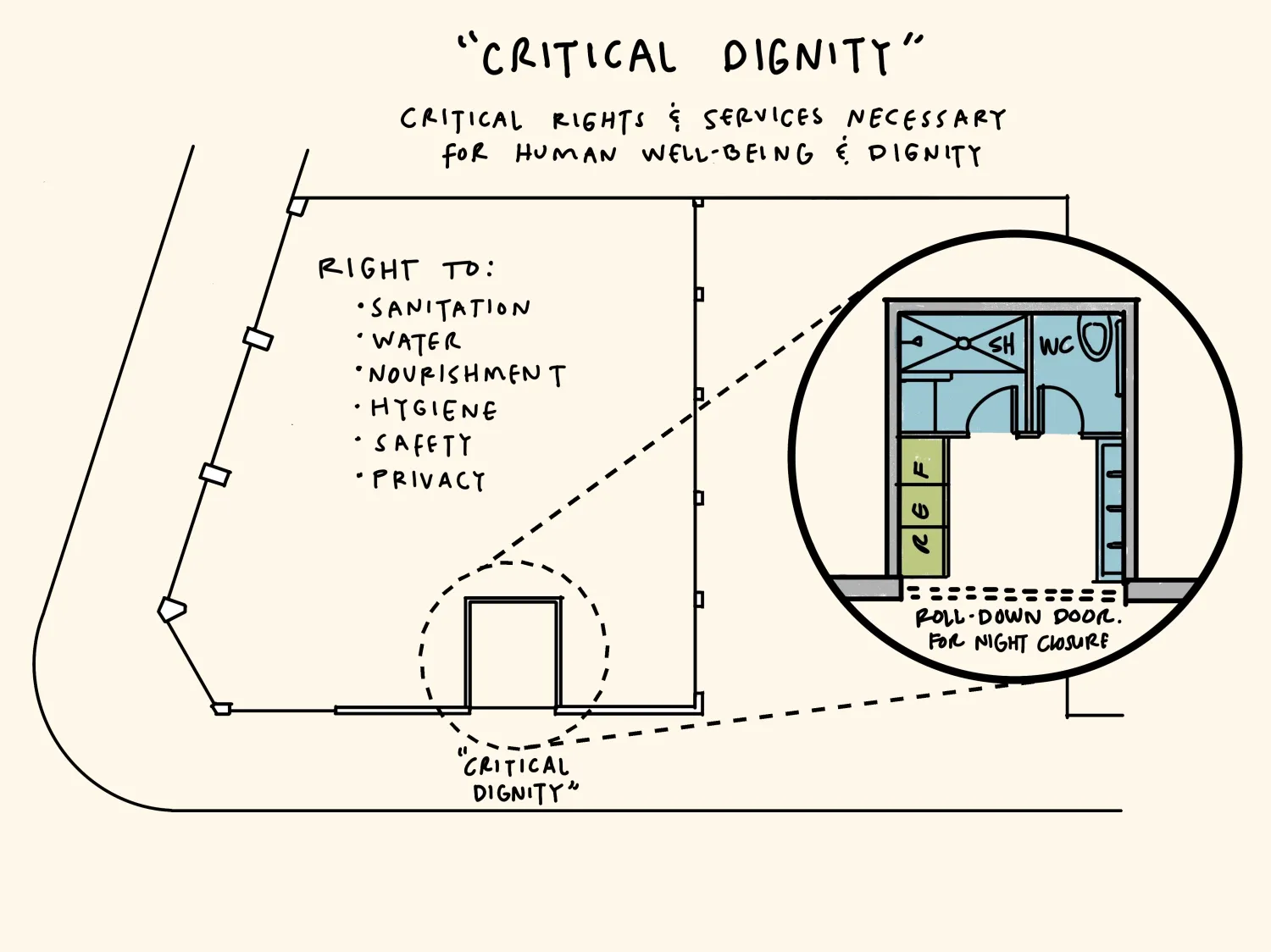
Some of the many potential functions of a Resilience Hub.
The environmental context in which we design is evolving. As we address climate change in a world of aging energy systems and building stock, we cannot afford for resilience to be framed as a “sustainability” add-on. When we talk about resilience, we are referring to the goals of future proofing and extending the useful life of buildings, keeping buildings operating and staff supported through critical events, and ensuring that residents remain safe and well in their homes. For us, resilience planning to meet these goals is embedded in and inherent to our design process.
At DBA, we are committed to resilience planning as a common-sense way to establish the user-centered program requirements critical to a successful building. When we start a project, it is essential for us to understand both owner and local community concerns and goals around building resilience and to take the time to identify the early design decisions that will lead to desired outcomes. As we engage clients and communities in a resilience planning process, we look for multi-benefit measures that we can embed into a project budget from the beginning.
Here is an overview of our process, some examples of resilience solutions, and how we are looking ahead as part of our Sustainability Action Plan.
Process
We begin with a conversation with each client that centers around focusing questions, such as:
Who will the building serve?
From the start, we consider the people who will occupy the building, making sure we know who the building is intended to serve and what specific needs, vulnerabilities, strengths, and assets they may present.
What risks are the highest priorities for this building?
Any given site may face multiple potential environmental risks, including but not limited to: extreme heat, severe storms, air quality events, power outages, earthquakes, flooding, and social instability. Developing an understanding of those risks and setting priorities with a client and community for what challenges a project should address is a critical step to successful programming and building design.
We have started to include risk mapping as part of our site assessment process for projects early in the design phase. In partnership with BuildingGreen’s Sustainable Design Leaders peer network, we have been building up a nationwide database of mapping resources and other tools to support more resilience-focused site assessments.
What are the most critical service continuities?
Many people jump to the idea of setting up a single space, or “hub” where people can seek refuge during an emergency. Although this can ultimately be a great solution, leading with an assumed solution is a good way to make resilience an add-on. The first step is always to consider what aspects of day-to-day life—safety and security, access to hot water, communications, or refrigeration for medicines—the building must offer to its users during a “normal” mode and then consider the emergency mode. In this sense, “resilience planning” is really one and the same with an inclusive design or trauma-informed design process. It is critical that this be a sensitive, human-centered conversation with representatives from development, property management, service providers, maintenance staff, and potential (or proxy) residents, if at all possible. We have seen that creating a forum for this kind of feedback almost always yields insights and surprises. Broadening engagement to gather feedback from community stakeholders can also be an opportunity to get buy-in, deepen trust and expand potential partnerships early in the development process.
What strategies are important for a successful response?
In addition to understanding site-specific risks and community vulnerabilities and assets, it is important to align with clients on what scale the resilience strategies will be implemented: serving residents in their homes, supporting building residents in common areas, or functioning at a broader community-scale.
At this point in our process, we often engage with our engineering teams to look at potential system solutions, critical building loads, and interventions that may address risk while providing other benefits, such as offsetting electrical loads at peak utility rate times.
Physical Resilience
There are innumerable specific strategies to support physical resilience. Here is just one example—addressing an extended power outage—something that is becoming increasingly common. To facilitate a discussion about managing an extended loss of power, which can be a complicated challenge for these buildings, we talk through various human-centered activities related to building services and operations to identify critical and ideal service continuities, as well as durations of service.
From this list, our design team develops a tally of critical loads and looks at options for providing emergency back up. This is an iterative process as we balance priorities between battery capacity and cost considerations. Battery technology is evolving, but we have yet to find appropriately scaled solutions at a price point that works for many developments, particularly affordable multifamily housing. Due to cost, many of our buildings that have been exploring energy resilience are being built as “battery ready” with the infrastructure in place to allow connection to a future battery investment. We have also been helping clients explore alternatives to gas generators, such as the Jackery portable battery pack for micro-scale resilience.
Fortunately, investing in batteries can offer multiple benefits, from backup refrigeration to prevent inventory loss in a restaurant, to preserving residents’ heat-sensitive medications. It is also possible to realize savings by shifting peak 4-9 PM loads through storage of energy produced on site during the day, a concept that we have been exploring in a number projects such as our proposal for the CEC Epic Challenge, a program sponsored by the California Energy Commission.
We are interested in the ability of community-oriented spaces to provide not only physical but social resilience. In developing our design for the net-zero energy Hotel Sebastopol, community resilience was an integral part of the process from early community engagement through client program development and engineering. The plan includes a community room intended to serve as a “resilience hub” – central meeting and support space– for wildfire events by providing MERV-13 air filtration and the ability to be connected to a future battery in the event of a power outage.
Often power outages overlap with heat and/or smoke events. In collaboration with the Association for Energy Affordability, we put together “Smoke and Heat: How to Prepare Multifamily Housing for Climate Events,” a workshop for housing providers to discuss strategies to prepare their buildings and tenants for smoke and heat events. We have also created Stay Healthy During Fire Season, “how-to” guides that have been distributed to tenants in a number of buildings in both English and Spanish.
Social Resilience
As architects, we have the opportunity to enhance existing social capital within a community by making spaces that encourage neighbors to interact and strengthen ties to one other. The more that a space functions daily as a “third place” for a community, the better it will foster collective resilience when that community is in crisis. We have been exploring models for this connectivity at various scales. We work with clients to design active and connected spaces in buildings alongside strategies for those spaces to support physical resilience needs, and also seek opportunities to explore resilience strategies that extend beyond property lines. Local Cache is an unbuilt collaborative design proposal for Resilient SF to enhance community resilience through connectivity in the urban environment.
Finding moments to engage the broader community both supports community vulnerabilities and enables community assets to increase overall resilience. We have been exploring models for this connectivity at various scales. “Critical Dignity” is a design study for a client interested in providing community resources for unhoused people. An alcove with a roll-up door provides the opportunity to offer secure public sanitation and refrigeration stations filled with produce from local gardens. We are currently helping this client navigate broader funding through a Community Resilience Center state-level grant to implement a resilience hub strategy throughout the building.
Looking Ahead (and Behind)
In our Sustainability Action Plan, we have set a goal for our office that by 2025, we facilitate community-oriented resilience and disaster preparedness planning on all projects. Based on successes from early pilot projects, we are looking to integrate these conversations as a more inclusive stakeholder discovery effort into all project planning processes. There is so much that we can learn from members of the communities in which we build about their vulnerabilities and assets, so we are continually looking for ways to expand these conversations as we engage with various communities.
Another way that we learn directly from our building occupants is by applying our “post occupancy toolkit," which includes templates for facilitating successful resident and staff interviews, site walks, and data collection. These tools can be deployed regularly on completed projects several years after project completion, or on any new project as a step in the pre-design process, and interlace with community and other stakeholder outreach. It is often through this process that we learn from staff and residents how a building performs (or does not) in critical events, as well as everyday usability and resilience. We welcome partnerships with other practitioners who want to adapt our tools and share their own.
It is exciting to see resilience being discussed more frequently, and being increasingly incentivized. For projects pursuing Affordable Housing and Sustainable Communities (AHSC) funding, the application asks about measures that address various risks, and the Green Point Rating system offers up to six points for resilience planning and implementation. Grant opportunities at the State and Federal level, and creative financing models such as Commercial Property Assessed Clean Energy (C-PACE) are supporting resilience investments.
How are you or your organization planning and designing for resilience? While our efforts are currently project-specific, we are very interested in expanding our resilience planning process to consider a group of buildings or a developer’s entire portfolio, which would explore efficient and scalable solutions that move the industry towards greater building resilience.
Erin Feeney, AIA, LEED AP, is an Associate at David Baker Architects and a key contributor to our Sustainability Action Plan. If you are interested in sharing resources or if your organization would like to collaborate with DBA on a resilience planning process. Email Erin Feeney.
